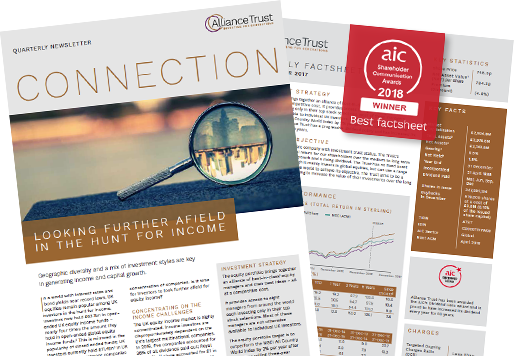Measuring performance of Alliance Trust
In this article, we explain why the Trust is changing the way its performance will be measured now that the sale of its remaining operating subsidiary, Alliance Trust Savings (ATS), has been completed.
On our monthly factsheets we quote three performance numbers for the Trust:
- Total Shareholder Return (TSR)
- Net Asset Value Total Return (NAV TR)
- Equity Portfolio Return (EPR)
In the long-term, the TSR is the most important as it is ultimately the only metric that can be used by shareholders to measure the return on their investment when they decide to cash in or value their shares. The TSR reflects the change in the Trust’s share price over the investment period and allows for the reinvestment of net dividends received from the Trust on the date that the share price goes ex-dividend. It is also net of all costs incurred in running the Trust.
However, in the medium term, for example over rolling 3-year periods, investment trusts tend to focus on NAV TR. This is because the NAV TR is what the Board and investment manager are accountable for; they cannot be held accountable for market sentiment and very short term swings in the share price, although buybacks can be used to smooth volatility. As with TSR, the NAV TR is net of all of the costs of running the Trust. Of course, in any short-term period the NAV TR can be significantly impacted by the positive or negative impact of borrowed capital, where the expected profits are greater than the interest payable, but this can be explained in any attribution analysis.
Alliance Trust is a special case, however, as it has been transitioning for some time from a multi-asset portfolio to one focusing on investing in global equities. Since the Board commenced its strategic review in 2016, the legacy non-core assets (private equity, mineral rights and a few other items) have been in the process of being sold. The Trust completed the sale of its asset management subsidiary company, Alliance Trust Investments, on 1 April 2017 and on 28 June 2018 the sale of ATS completed. The proceeds of sale of these investments have been reinvested into the Trust’s global equity portfolio. There are now less than £14m with of assets left outside equities, and these will be realised before year end.
Since its appointment on 1 April 2017, Willis Towers Watson has been responsible for managing the Trust’s global equity portfolio. It is expected that global equities will make up 100% of the NAV of the Trust by the end of 2019. Therefore, in order to judge how well Willis Towers Watson has been doing as the Trust’s investment manager since its appointment, and in order to understand the performance of what will make up 100% of the NAV in the future, we have focused on reporting the EPR.
While the EPR is technically the return on the global equity portfolio before manager fees are removed, this has actually been the most indicative calculation of what the NAV TR would have been after fees without the non-core assets and operating subsidiary companies since the current investment approach was adopted. This is because the positive impact of leverage and buy-backs (included in the NAV TR but not in the EPR) have almost exactly offset the total costs of managing the Trust (also, included in the NAV TR but not in the EPR) over that period (and as expected in the very long term).
We have been measuring the EPR against the MSCI All Country World Index Total Return (MSCI ACWI). There are two return series for the MSCI ACWI, namely, the gross dividends reinvested (GDR) and net dividends reinvested (NDR) series. GDR assumes that no withholding taxes are paid on dividends received from the companies that make up the index, while NDR assumes full withholding taxes are paid. The GDR is purely theoretical - nobody can actually receive that return, even if they invest in an index-tracking product, as every investor has to pay some withholding taxes.
Different investors are able to reclaim different amounts of withholding tax paid at source, but nobody can reclaim all of it. As a result, most market participants would agree that the NDR series is the most appropriate one to use as a benchmark. Indeed, the various index-tracking global equity funds on the market typically measure themselves against the NDR series, and most of these that are available to the retail market perform worse than the NDR series after all costs. While the change from the GDR variant to NDR will increase our strategy’s outperformance versus the index, this is not what we are switching. We are making the change because it is a more realistic comparison of the return from the index.
In summary, for the period between 1 April 2017 and the current date, we believe that the most appropriate comparison has been the EPR versus the MSCI ACWI NDR. However, now that the sale of Alliance Trust Savings has been completed and, as the vast majority of the Trust’s non-core assets have been disposed of, we believe that the most appropriate way to judge the performance of the Trust is by by comparing the NAV TR against the MSCI ACWI NDR. This is the performance measure we will focus on now that we are a pure global equity trust.






